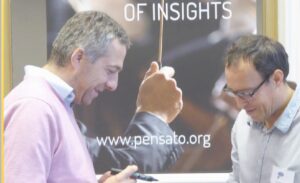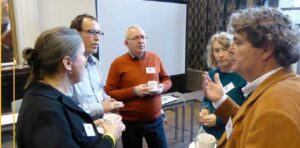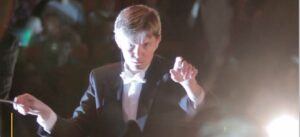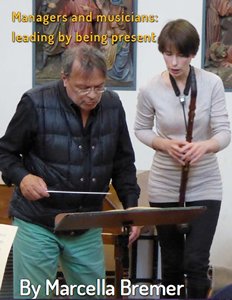 Can musicians teach managers how to be better leaders? Maybe not. Teaching implies a top-down approach: transferring insights from one person to the other. But managers can learn from musicians. Learning implies a bottom-up process: pulling out, becoming aware of what is already present inside… Join me, as I learn from musicians in this workshop with an orchestra!
Can musicians teach managers how to be better leaders? Maybe not. Teaching implies a top-down approach: transferring insights from one person to the other. But managers can learn from musicians. Learning implies a bottom-up process: pulling out, becoming aware of what is already present inside… Join me, as I learn from musicians in this workshop with an orchestra!
I cannot teach anybody anything – I can only make them think. That’s what Socrates said – as Dominique Dejonghe tells us. We’re a group of eight managers and consultants convened at the conservatory in Brugge, Belgium. Dominique and his colleague Luc Galoppin guide their workshop “Pensato – A symphony of Insights”. The two consultants work together with the Brugge-based professional orchestra “Anima Eterna Brugge” led by conductor Jos van Immerseel. Anima Eterna specializes in authentic music – played with authentic musical instruments that were used when each composer composed their pieces. They deliberately miss out on instrumental innovations that happened since then – they aim for the authentic, historical source.
 Anima Eterna has an international reputation and consists of varying projects of professional musicians with authentic instruments – depending on the repertoire – playing from original scores (no adaptations). Their Carmina Burana project was performed with 110 musicians from 22 countries while a Haydn project will only take 15 musicians. Jos van Immerseel, the conductor, believes in the drive and expertise of individual musicians who love authentic music, who value their autonomy and get together with the best of the best colleagues for each project. He doesn’t believe in a fixed orchestra. Every project is set up from scratch, finding the musicians with the right instruments, deciding on the repertoire and the schedule. Forget the settled orchestra with its culture and animosities “O, them violinists! Ah, it’s always the same…” Instead, enter a temporary space, devoted to authentic music, where the present moment is all that counts.
Anima Eterna has an international reputation and consists of varying projects of professional musicians with authentic instruments – depending on the repertoire – playing from original scores (no adaptations). Their Carmina Burana project was performed with 110 musicians from 22 countries while a Haydn project will only take 15 musicians. Jos van Immerseel, the conductor, believes in the drive and expertise of individual musicians who love authentic music, who value their autonomy and get together with the best of the best colleagues for each project. He doesn’t believe in a fixed orchestra. Every project is set up from scratch, finding the musicians with the right instruments, deciding on the repertoire and the schedule. Forget the settled orchestra with its culture and animosities “O, them violinists! Ah, it’s always the same…” Instead, enter a temporary space, devoted to authentic music, where the present moment is all that counts.
 A “Pensato” is a musical note that is written in a score – but that is not heard when the music is performed. In the same way, the Pensato workshops help leaders discover “invisible” things when they observe the Anima Eterna musicians. The formula is simple: bring the top musicians of Anima Eterna together with smart managers. Let the managers observe what happens during the rehearsal – and let them understand what they saw so they may apply this back in the office. Next, let the managers tell the musicians what they noticed. Both parties can learn from this exercise. Moreover, it helps build a relationship between the orchestra and corporate managers. In Flandres, as anywhere else, orchestras depend on grants to stay in business – a fan base of managers will help Anima Eterna perform their authentic music on stage.
A “Pensato” is a musical note that is written in a score – but that is not heard when the music is performed. In the same way, the Pensato workshops help leaders discover “invisible” things when they observe the Anima Eterna musicians. The formula is simple: bring the top musicians of Anima Eterna together with smart managers. Let the managers observe what happens during the rehearsal – and let them understand what they saw so they may apply this back in the office. Next, let the managers tell the musicians what they noticed. Both parties can learn from this exercise. Moreover, it helps build a relationship between the orchestra and corporate managers. In Flandres, as anywhere else, orchestras depend on grants to stay in business – a fan base of managers will help Anima Eterna perform their authentic music on stage.
Observe, observe, observe
We’re with eight observers and we are intrigued. How is leadership practiced in an orchestra? How can music bring synergy to an organization? How can music enhance learning? Can we translate our insights to a business context?
The Anima Eterna musicians get together for their very first rehearsal for this project. Some flew in this morning, jet-lagged. We are to sit between the musicians, as if we were part of the orchestra, notepads on our laps, while they will start 2-3 days of rehearsals before their first performance together. Some musicians have never met before, others know each other longer.
 It’s magic to sit between these professionals. Jos van Immerseel lifts his baton and after a second of silence, they play, right away, and we’re immersed in Mozart’s Clarinet concert in A.
It’s magic to sit between these professionals. Jos van Immerseel lifts his baton and after a second of silence, they play, right away, and we’re immersed in Mozart’s Clarinet concert in A.
The experience is totally different than sitting in a concert hall audience. I see Jos’s facial expressions as he conducts the musicians through the piece. I see how he makes eye contact with the musicians in the first row, fractions of time before they get to play their parts. The soloist clarinetist, Lysa Shklyaver, sways together with the first violinist, riding the same flowing energy. The conductor nods and provides only minimal cues. All musicians look relaxed and they seem to enjoy playing. They are in constant contact with each other – breathing, watching, moving together.
 We change positions and I sit with the second row of musicians. As Van Immerseel stops the piece to give directions to the first row, they lean back and shrug. “Can’t hear a word he’s saying.” They wait while he consults with the soloist, patiently. But they don’t seem fully included. One musician makes a face, another seems distracted – or maybe just tired? When the rehearsal continues, they start their part a fraction too late.
We change positions and I sit with the second row of musicians. As Van Immerseel stops the piece to give directions to the first row, they lean back and shrug. “Can’t hear a word he’s saying.” They wait while he consults with the soloist, patiently. But they don’t seem fully included. One musician makes a face, another seems distracted – or maybe just tired? When the rehearsal continues, they start their part a fraction too late.
But what have we seen?
After the observation session, we observers get together to discuss what we have noticed. What have we seen regarding leadership behaviors, communication and feedback? It’s a fascinating exercise. We have our notepads scribbled full with observations – and everyone has seen different things. More importantly – we have seen so much. I observe groups of people all the time when I work with them – but I’ve never seen so much before. It is palpable: the energy of playing together – the nonverbal cues – but also the people who don’t fully join in.
More important than the baton is eye contact and smiling. Most communication happens nonverbally, between conductor and musicians and between musicians. A mistake is excused with an apologetic smile. A nod signals approval and appreciation. Breathing together creates the same energy, pace and trust.
 What would you expect when you start a project with partly new professionals? A motivational speech. “Welcome everyone. So glad we can get started on…. Hope everyone will contribute their best so that we can reach this or that goal.” We expect default leadership behavior: taking the lead, making things explicit. Jos van Immerseel doesn’t do that. He doesn’t raise his voice, he only lifts the baton and he has the orchestra’s attention. They are dedicated and they are super professionals. No need to motivate the musicians to play better – there’s only a need to hold the space in which they can play better together. Preparation and intention was all it took to create that space in which they play together. No need for speeches or being the boss. “People come here because they want to play”, says Van Immerseel.
What would you expect when you start a project with partly new professionals? A motivational speech. “Welcome everyone. So glad we can get started on…. Hope everyone will contribute their best so that we can reach this or that goal.” We expect default leadership behavior: taking the lead, making things explicit. Jos van Immerseel doesn’t do that. He doesn’t raise his voice, he only lifts the baton and he has the orchestra’s attention. They are dedicated and they are super professionals. No need to motivate the musicians to play better – there’s only a need to hold the space in which they can play better together. Preparation and intention was all it took to create that space in which they play together. No need for speeches or being the boss. “People come here because they want to play”, says Van Immerseel.

Does the conductor act like a leader?
When we discuss our observations afterward with conductor Van Immerseel and a few musicians, he says: “A small group doesn’t even need a conductor. I’m not that important. My added value is the musical interpretation, here and there, and we can rehearse faster because I facilit33ate the process.
A larger group needs a conductor – and you can make them sound as you like. Large orchestras are too much like a machine to me. I prefer the smaller group, that still has its own energy. Musicians who play together create their special interpretation of the music, their sound. I listen to the propositions of the musicians when they play – they are the professionals. Then I adjust. I don’t start with a fixed idea: “Mozart should sound so and so.” I see what emerges from the group and go with that. The performing arts are really the ‘presencing’ arts.” Being present and responding to what happens is key.
Van Immerseel doesn’t like the pure democratic orchestra. “Their performance lacks character.” Rather he builds on what individual musicians contribute as they play and extends on their interpretation. What stands out, both during the rehearsal as when we discuss our observations, is the mutual respect between the conductor and musicians. Jos van Immerseel started out as a pianist – and they respect him as a fellow musician.
 Cellist Stefano is new to the orchestra and says: “Jos gives you the freedom to play the notes your way. It’s this freedom that we love as performing artists.”
Cellist Stefano is new to the orchestra and says: “Jos gives you the freedom to play the notes your way. It’s this freedom that we love as performing artists.”
This is an advantage of an organization of super professionals. They love their work – they want to be the best – and all the leader needs to do is create the space for them to work together and excel. However, to my surprise, I have seen typical “back row behavior”. Super pros or not, people are still people. Group dynamics happens: everyone wants to be seen, acknowledged, included. Even super professional, autonomous adults appreciate a smile or a compliment. The back row was literally too late with their part – because they weren’t as fully included as the first row was. The back row seduces people to behave like they did in school – eye rolling about the teacher, having their private conversations.

Hold the space
I personally think that Jos van Immerseel is more important than he claims to be. He is a servant leader, serving the music and the musicians, but still a leader. His attention for the whole piece (instead of just the part that one musician plays) creates the space in which the music can emerge and exist. His attention includes the back row – or not – resulting in a different energy and experience for everyone. His attention goes to the interpretation that is most likely to manifest itself – emphasizing one contribution over another. Even though the performance is a group effort – it needs a catalyst. The leader is such a catalyst.
But everyone has their own conclusions. We have observed so many nonverbal behaviors, so many ways of being – all participants have learned a lot.
What stands out, is that leaders don’t have to spell everything out. Action speaks louder than words, or should I say: presence speaks louder than words. Be present with your people when you lead professionals. Hold the space and let the team unfold itself – don’t get in their way – but adjust and align so they focus in the same direction. This workshop is highly recommended. Take the conductor’s words to your heart – and make sure to work with people who want to play…
* How can you make eye contact and smiles more important than “your baton” at work?
* How can you help create a space wherein the work can manifest itself?
* How can you help your team excel in the space you create with respectful attention?
* Who is part of your “back row”? How can you include them in the space?
Dominque Dejonghe and Luc Galoppin may be contacted at https://www.pensato.org/
Photography: Phdpictures
Anima Eterena: https://www.animaeterna.be/
